Dragon Fruit
All about Dragonfruit / Pitaya / Pitahaya Fruit
Pitaya Fruit, Pitahaya Fruit or commonly known as the Dragon fruit is among the most nutritious and wonderful exotic fruits. It is a favorite to many, particularly people of Asian origin. It features a mouth watering light sweet taste, an intense shape and color, not forgetting its outstanding flowers. In addition to being tasty and refreshing, this beautiful fruit boasts of a lot of water and other vital minerals with varied nutritional ingredients.
Due to its vital nutrients, the Pitaya fruit is suitable for all diets as it supplements fiber which is best for laxative and the liver. Similarly, people who have high blood pressure, diabetes and obesity have attested to the fruit’s goodness. Recent findings show that if an obese person eats a Pitahaya fruit on a regular basis, it naturally reduces the weight considerably, creating a well balanced body without compromising on the individual’s health.
Pollination of the dragon fruit
The dragon fruit is precisely of the Hycocereus undatus family, thus making it one of the widespread red dragon fruit. Typically, the fruit has red pulp, or red flesh if you like. The fruit originates from the dragon fruit cactus plant, which usually appears like vines. Unlike day pollination done by bees, it is surprising to note that this nutritious and tasty fruit blooms at night where pollination is caused by nocturnal living things such as bats and moths. What is more, it blooms a few times annually, blossoming with the now synonymous huge aromatic buds.
Despite the fact that people avert and dislike bats, they play a very important role in the pollination and formation of these dragon fruit cactus plants. This is because the dragonfruit cactus plant will only come out successfully after a complete pollination process. Note that even dragonfruit plants that carry out self pollination fail to create a dragonfruit cactus if they don’t get the assistance of the bats. In simple terms, the bats carry out a successful and proper pollination process of the dragonfruit cactus plant to bring out the delectable fruits that we relish.
You can stay healthy by eating a dried or fresh Pitaya. For the people suffering from diabetes, a dry or fresh Pitaya guarantees one of blood glucose control. Basically, a dry dragonfruit has about 10 times the punch of a fresh one, with an amazing chewy feel. To get a simple, healthy chewy texture, blend in a dried pitahaya into your salads. On the other hand, a fresh dragon fruit features a soft creamy feel.
That said, you can eat dragonfruit as a desert, raw, of you can make its juice and use in cocktails. Cocktails of ice cream are an example, or you can even ferment the cocktail into a mouthwatering healthy alcoholic beverage. In Taiwan for instance, the Pitaya fruit is used by diabetics to substitute food for rice and to enhance the fiber content of the diet.
Nutritional Value of a Typical dragon fruit
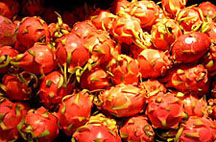
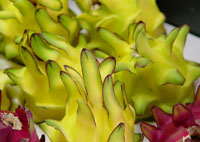
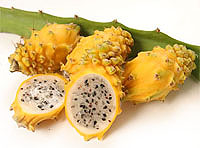
Pitahaya fruits are highly concentrated with Vitamin C, minerals and boasts of high fiber content. The following table shows a characteristic nutritional value of the dragonfruit.
Equally available in affluent in a dragonfruit is phytoalbumins. Basically, these nutrients are vital and known world over for the antioxidants they possess which usually help in the prevention of the formation of free radicals that cause cancer.
| Fiber | 0.9g |
| Fat | 0.61g |
| Ashes | 0.68g |
| Carotene | 0.012g |
| Water | 83.0g |
| Phosphorus | 36.1mg |
| Ascorbic Acid | 9.0mg |
| Protein | 0.229g |
| Riboflavin | 0.045mg |
| Calcium | 8.8g |
| Niacin | 0.430mg |
| Iron | 0.65mg |
Importance of eating a Pitaya fruit
- Carotene helps maintain and equally improve the health of the eyes
- The fiber enhances digestion in our bodies
- The fiber equally reduces fat
- The protein component of the pitaya fruit enhances the body’s metabolism
- Calcium reinforces bones and aid in formation of healthy teeth
- Vitamin B2 acts as a multi vitamin to recover and improve loss appetite
- Vitamin B1 assists in production of energy as well as metabolizing carbohydrates
- Vitamin B3 lowers bad cholesterol level and enhances the appearance of the skin by moisturizing and smoothening it
- Vitamin C ensures bruises and cuts heal faster and improves the general immune system of our bodies
- Phosphorus aids in tissue formation.
Component Statistics of dragonfruit
As mentioned above, eating a dried pitaya fruit equals eating 10x the punch of a fresh pitaya fruit, constituting essential vitamins such as Vitamin C, micro nutrients and fiber. Thus, consumption of 1.5 oz of a dried dragonfruit, equates to almost eating a full pound of the fresh dragonfruit. Note that all the necessary and important dietary fiber, micro nutrients and vitamin C are still in abundance in a dried dragonfruit.
While a fresh pitahaya fruit contains lots of water, justifying the soft creamy texture you feel when eating it fresh, a dry Pitahaya fruit features a chewy feel, and generally appears darker than the fresh fruit. This then explains the phrase “color your diet” for this amazing fruit rich in all vital nutrients that your body requires, and what is more, it is very easy to eat.
Species of pitaya fruit
Misrahi Y. and Nerd A. have written an outstanding piece of work about the dragonfruits entitled “Climbing and Columnar Cacti: New Arid Land Fruit Crop”. Because of the apparent confusion while naming the species in different parts of the world, the two authors have tried to demystify the confusion.
|
Botanical and common names of a number of the Climbing Cacti
|
Botanical and common names a number of columnar cacti
|
The History of the Dragon fruit
The dragonfruit is native to Central America. According to Aztec literature, Pitahaya fruits date back to the 13th century. In Vietnam, where it is extensively grown, Pitaya fruit is known as thang loy. It is believed that the fruit was introduced to Vietnam by the French and today, the average yield per hectare is 20-25 tonnes.
Malaysia is another region where you are sure to find the dragonfruit. It was first introduced in 1999 in the Sitiawan, Johor and Kuala Pilah regions. Colombia and Nicaragua are other places where pitahaya fruit is grown for commercial purposes.
These regions attest to the fact that Pitaya cactus fruit requires a warm climate thus prospers well in semi-arid areas. Planting the fruit has very high prospects since it’s industrially used in juices, making wine and flavorings, not forgetting its medicinal value which a lot of people have grown to trust.
Growing the Dragon Fruit
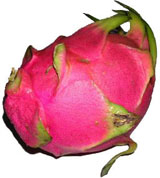
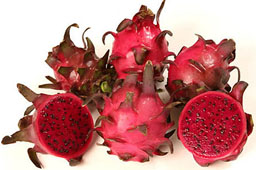
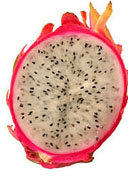

Generally, the fruit needs a temperate rainfall of around 600-1300mm and a maximum temperature of 38-40 degrees Celsius. Be advised that too much rainfall leads to flower drop and the fruits will rot.
By and large, it requires a tropical climate, especially when growing for commercial purposes to have successful and fruitful plantation. Red dragon fruit featuring red skin and red flesh, pitaya fruit featuring white flesh and yellow skin and the red pitaya fruit featuring white flesh and red skin are the three most common varieties cultivated for commercial purposes. Additionally, they all feature the dragon fruit pulp or flesh filled up with tiny black seedlings, normally eaten together with the fruit.
On the other side, if you want to grow the pitaya fruits for non commercial purposes, you can easily do that at home by using the seedlings found in the fruits that you eat, since you aren’t growing them large scale.
Getting started is quite easy, but you maybe required to learn a bit more about how to grow the fruit to mellowness to produce pitaya cactus fruit successfully. Basically, both commercial and non commercial growers may find short blossoming durations and night blossoming makes pollination of your Dragon fruit difficult. As mentioned above, successful pollination is by nocturnal creatures such as bats and moths, and a set back maybe you aren’t living in an area where these creatures are many.
The biggest challenge for the hobbyist is getting recurring successful fruitings of mature pitaya fruit cactus. Nonetheless, wherever part of the world you are, it can be fun to grow pitaya fruits. You can use cuttings or seeds; beware though that the seeds may take a bit longer.
You are likely to spot the Hylocereus undatus/ocamponis/polyrhizus in Malaysia and Taiwan and the Hylocereus, Selenicereus and Cereus genera in Vietnam, Israel and Central America. Since the demand for the dragon fruit is high, the projections of it becoming a plantation crop are very high.
While cultivating the climbing cacti, one may need wooden posts, trellis, metal rods and concrete posts to support the plants, which is not necessary while cultivating the columnar cacti. The climatic conditions of the area you are cultivating, in addition to the cultural and economic criteria will basically determine the supporting structures that you will use.
Horticulture
Rainfall
As mentioned above, the optimal rainfall of the cacti should be between 600-1300mm since excess rainfall will cause the flowers to drop, definitely reducing the fruit set. The biggest enemy of the cacti is waterlogging as it kills it. Equally, excess humidity causes proliferation of soft rot caused by the Erwina Carotovora bacteria. A dry rot on the other side is caused by extreme soil moisture.
Light Tolerance
In conditions that have excessive light intensity, it is advisable to provide shade. There are species that are susceptible to bleaching when exposed to high radiations. Thus, such species should be grown under net houses. These are species that originate from tropical and subtropical America, while other species like the H. polyrhizus withstands high light intensity, thanks to their thick waxy skin.
Temperature Tolerance
Just like the rainfall, excessive temperature can damage the Pitahaya fruit. Optimal temperatures should be between 38-40 degrees Celsius. Some species like the Hylocereus undatus are extremely sensitive to high temperature. The effects include abnormal browning and the stems of the affected plants may end up liquefying. Flowering is equally affected by excessive temperatures.
Selecting and storing Pitaya fruits
Selecting the fruit is very simple, simply look for full-bodied, full colored fruits which are free from any moldy spots. You can store the Pitaya fruits in refrigerators, unwashed for up to five days.


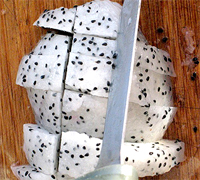
Eating the Dragon Fruit
Ways of eating the dragon fruit are as many as the medicinal values of the fruits. If you relish eating them fresh, you can peel off the skin by spooning it, just the same way you do to a papaya. Equally, you can slice the pitaya, blend in a smoothie and eat with lime or lemon or better still add to your fresh fruit salad. You can eat it chilled or cold, the choice is all yours but what you should know is that it is mandatory to eat the pitahaya fruit!
our partners: feline portal www.meow-cats.com. all about cats, cat breeds, different types of cats, cat and kitten care and more | all about summer wear – beach summer dresses, beach accessories, swimwear and more | incredible benefits of using safflower oil in your kitchen and cosmetics.
All about dragonfruit / pitaya / pitahaya fruit | Pollination of the dragon fruit | Nutritional Value of a Typical Dragon Fruit | Importance of eating a Pitaya fruit | Component Statistics | Species of Pitaya Fruit | The History of the Dragon fruit | Growing the Pitaya Fruit | Horticulture | Eating the Dragon Fruit